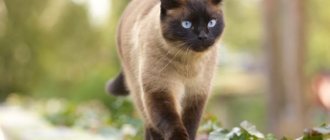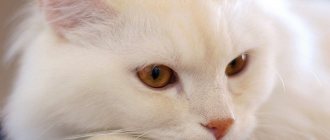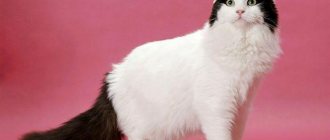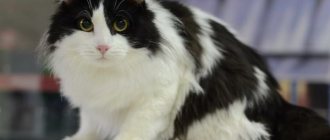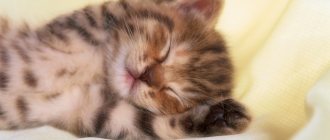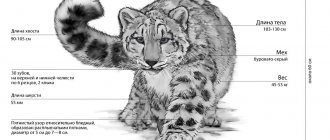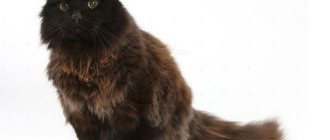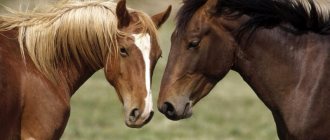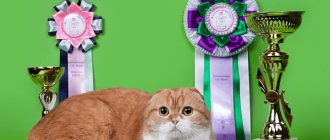Cinnamon is a rare color among the British
My love for the cinnamon-colored British sparkled in me from the very first glance at the photograph of our then very little Umochka.
This girl immediately captivated me with her not childishly serious look and short plush fur coat of a very warm and light shade of chocolate. Today, Uma has a coat of a beautiful and rich color of freshly ground cinnamon. And its stunning color is called cinnamon, which is translated from English as “cinnamon”. The cinnamon color was first discovered in Abyssinian cats. And the discoverer of this exclusive was the Dutch breeder of Abyssinian cats Maria Falkena-Rohrle, the founder of the Van Mariendaal breed line. But before, not far from 1980, Maria heeded the advice of the chairman of the independent Dutch club Ineke Zegers, to submit an official application for recognition of the color she discovered. She did a huge amount of work over almost a decade and a half and already had more than 25 cats in her cattery with a strange “cinnamon cookie” color.
Thus, on April 19, 1980, cinnamons were recognized by the NKFV club as “foreign shorthairs.” And in 1982, some independent Dutch clubs recognized the fawn color (translated from English as “fawn”) as a lightened version of the cinnamon color. In Orientals, the cinnamon color was confirmed by FIFE in 1991, and in Siamese only in 2004, although in the Oriental breed it was also obtained by 1980.
Cinnamon , and its lightened variant fawn , are currently very popular and fashionable colors among British Shorthair cats. If we compare them with the classic colors of the British, then we can firmly say that cinnamon and fawn are rare and new colors in the British breed. Received, by decision of the WCF General Assembly, official recognition only from the beginning of January 2009.
Cinnamon-colored cats appeared in the British breed thanks to the efforts of several European catteries, which, through experimental interbreeding of British cats with representatives of cinnamon-bearing breeds such as Somalis, Orientals, and Siamese, achieved the seemingly impossible by mating complete opposites with each other.
Work on this complex and amazingly beautiful color is ongoing to this day. Breeders of many Russian and foreign nurseries, through competent selection of pairs of sires, make a lot of effort to improve the type of British kittens and cinnamon-colored cats.
Representatives of the British breed of cinnamon color have, noticeably different from the chocolate color in their warm and light shade, red-brown coat color with a copper tint and a slightly lighter yellow-brown undercoat. The paw pads and nose surface of cinnamons are colored the color of cocoa heavily diluted with milk with a light pink tint. In kittens, they have an even more delicate and lighter shade of pink, similar to the skin color of a small child. I would call this color beige-pink. However, like cats of fawn color. But during times of stress, the paw pads and nose of the British cinnamon color change, they darken to the color of milk chocolate with a slight hint of red.
The Cinnamon and Fawn colors are definitely among the unusually beautiful colors in the British breed.
And what’s very nice is that they can be found for a long time in the most diverse and interesting variations - these are cinnamon turtles, fawn turtles, cinnamon bicolors, fawn bicolors, cinnamon points, fawn points, cinnamon and fawn tabbies, as well as ticked cinnamons and ticked fawns. In conclusion, I would like to add that, like all children, kittens of any color, regardless of their belonging to a particular breed, are always very cute and funny. But the British dogs of the cinnamon and fawn colors are something surprisingly tender and magical.
What colors do Abyssinian cats have?
Today, Abyssinian cats are considered one of the most expensive breeds. To some extent, this is due to a beautiful “fur coat” with a beautiful color. The most common animals in the world with this coat color are:
- classic wild;
- sorrel;
- blue;
- faun;
- brown;
- lilac;
- tortoiseshell;
- silver.
Among all other colors, wild is the most popular
Thanks to uniform ticking throughout, these cats have a kind of “calling card” - each hair along its entire length is colored in different (light and dark) shades.
The wild classic color is the fundamental color of the “fur coat” of representatives of this breed.
For a long time, only the wild color of the Abyssinians was recognized
The classic wild color is characterized by the following features:
- Presence of uniform ticking throughout all parts of the body.
- The body is distinguished by a more saturated orange-brown color.
- On the inside of the paws, as well as on the tummy, the fur is colored buffy.
- There is black feathering on both the front and hind legs. In many animals it even transfers to the pads.
- Along the entire ridge line there is a fairly wide black stripe, which smoothly ends at the very tip of the tail;
- The brick-colored nose is outlined along the edges with a darker edging.
- Abyssinians can have eyes of different colors: green, hazel or golden. However, it is worth noting that all kittens are light blue until about ten months of age.
Wild color is also the most commercial
Today, wild color is the most common among Abyssinian cats. In addition, many cats have this coloring at the genetic level.
Sorrel color
The color sorrel (red) is a lightened tone of the classic color. This shade was officially recognized for the Abyssinian breed in 1963, but until the late 70s it was most often called red.
The sorrel color involves a smooth transition of several warm shades into each other.
Animals that have this color attract attention because the color of their coat is a mixture of several rich shades: reddish, copper, bright apricot, and chocolate brown.
The characteristic features of sorrel include the following:
- Most pets have coats that are bright copper in color.
- There are two types of ticking: both dark chocolate and cinnamon shade.
- The inner side of the limbs and the abdominal area are covered with the lightest hair.
- A red-brown stripe runs along the spine, which is much darker than the dominant shade of the coat. The color of the tail is rich brown.
- There are beige-pink pads on the paws, and light chocolate flesh is visible between them.
- The nose has a pink tint. It is edged with a dark red rim.
- The most common eye colors among representatives of the breed are copper and gold. However, some Sorrel-colored pets have greenish or light brown eyes.
Sorrel is the calling card of the Abyssinian, not found in other breeds
Blue color
Organizations have officially approved the blue color for Abyssinian cats. Such animals differ from others by having a “fur coat” of a delicate and very impressive color.
The following standards are established for these animals:
- On the head, back, and head there is a characteristic pattern resembling a tailcoat, which has a beautiful bluish-gray color.
- On the chin, the inside of the limbs, in the abdomen and chest, the color of the coat is lighter - fawn, beige, pale brown, cream or apricot.
- The undercoat is a lighter shade than the main color.
- Ticking is present throughout the body and has the characteristic shade of an overcast sky.
- A fairly thin stripe runs along the entire spine, which stands out against the background of the ticking in a brighter blue color.
- The nose of these animals is either brown or gray-blue, but always has a dark edging.
- Pale pink paw pads are covered with sparse bluish hair.
- Eyes with a blue color are often golden and copper, but cats with green and hazel are often found. At the same time, many people pay attention to their special expressiveness and unique beauty.
The blue color received the green light from the exhibition managers not so long ago
Fawn color
The unique color fawn (translated as “fawn”) was approved in 1989. Today, this color is considered the rarest and most modern coat color. In essence, it is a shade of sorrel, but lighter.
Fawn - the lightest and softest of all colors
Characteristics:
- The fur on the body is a coffee or cocoa-with-milk color.
- A stripe with a darker beige-pink color runs along the spine.
- At the tip of the tail the fur is a rich pink-beige color.
- The guard bones, like the undercoat, are colored cream or pale sand.
- Throughout the body there is ticking of a combined color: cream with lilac-beige.
- In the tummy area and on the inner surface of all legs near the body, the fur has a specific oat color.
- Pink nose with reddish edging.
- The paw pads are covered with sparse beige-pink fur.
- Different eye colors: copper, golden, greenish, dark hazel.
Despite its prevalence, the faun is still awaiting recognition
It should be noted that representatives of this breed can have other colors: brown, tortoiseshell, lilac or silver. However, despite the fact that recently they are found quite often, they are not considered to be generally recognized coat colors.
If you properly care for an Abyssinian, he can live for about twenty years. However, some animals exhibit genetic pathologies such as polycystic kidney disease, atrophic retinopathy of the eye, and blood diseases caused by the destruction of red blood cells. In addition, cats often suffer from gingivitis and leukemia.
Abyssinian cats can safely be called long-livers
To prevent the development of many diseases and all kinds of complications, the following rules must be followed:
- Maintaining a proper diet.
- Brush your teeth twice a month.
- Brush the coat once a week with a special brush to remove dead hair.
- Trim nails as needed.
- Get checked by a veterinarian.
- Get vaccinated.
We invite you to read: Instructions for use of the drug Azinox for cats
Definition and a bit of genetics
Cinnamon color appeared relatively recently and is a rare color. The bearer of such an unusual color is the British cat breed. Sometimes you can hear how the color is also called cinnamon, which comes from the word cinnamon. This is not surprising, since the fur is reddish-brown. This color is usually classified as black-brown, determined by the pigment eumelanin.
If we look at the situation from a genetic point of view, then the formula contains a dominant allele B - black , thanks to which it is possible to guarantee the production of a dark pigment. When animals have it, the fur coat is painted in classic colors. We are talking about black or blue. In the latter case, dilution occurs due to the D gene, which is responsible for color dilution.
In this regard, the hair of the coat is poorly filled with eumelanin molecules, which leads to a gray-blue color. When the B – brown allele is additionally present in the color, the color of the animal will be either chocolate or diluted. Lilac color is not uncommon and is even more common than chocolate. At the same time, the presented allele affects the fact that the black pigment is, as it were, displaced from the general structure. This affects the lightening of the brown tone.
Several decades ago it turned out that there is another alley responsible for the color of the coat, its name is BL - brown light - light chocolate. Thanks to it, you can get the cinnamon color in cats.
What genes are responsible for the color and tone of the coat?
Some people think that we are talking about the color orange, but this is not so. And gold is none of the other non-dominant colors. The presented shade is a bright base, but there are also other colors in the overall tone. Thus, a pet's collar is usually white or purple. At the same time, some other areas may be as dark as possible. Golden pets are not the colors that are chased, although they are incredibly beautiful and bright.
A particular coat color is determined by the level of melanin, as well as the coloring pigment present in the animal’s body. Experts distinguish two types of substances that provide the basic colors of cats:
- Eumelanin is responsible for the presence of black ticking.
- Pheomelanin is responsible for the red tint of fur.
Nowadays there is still a struggle for the recognition of new colors of the Abyssinian cat
The black series of colors includes several different shades. They depend on the following set of genes:
- B (black) is a dominant gene responsible for black color.
- b (brown) is a recessive gene relative to B, and a dominant gene relative to bl. The presence of a rich chocolate shade depends on it.
- bl (brown light) is a recessive gene that is present in the body of pets with the Sorrel color.
Thanks to the above genes, which belong to the so-called “black group,” active synthesis of eumelanin occurs. And the O gene is responsible for the red color of the coat, thanks to which pheomelanin is produced.
Abyssinian kittens are very fluffy, the breed can only be recognized by their color
According to research, the color of animals depends not only on color, but also on tone. The gene code contains a dominant gene D (dense), as well as a recessive gene d (diluted), which, in fact, give a rich light or dark color.
In addition to separation by color, there is a coming trend of demarcation between the European and American types of Abyssinian cats
Dominance, like recessivity, manifests itself in such a way that dominant DD genes or a dominant gene with a recessive Dd can be combined - these combinations give a dark shade. In addition, recessive dd genes are also combined, resulting in a lightened coat tone.
We suggest you familiarize yourself with: Dr. Clouder cat food
In the pedigree trees of Abyssinian cats (abbreviation ABY), the letters n, o, a and p are used to designate colors.
Table 3. Dependence of color on a set of genes
| Color | Designation | Genes |
| Wild color | ABY n | BBDD, BBDd, BblDD, BblDd |
| Sorrel | ABY o | blblDD, blblDd |
| Blue color | ABY a | BBdd, Bbldd |
| Faun | ABY p | blbldd |
Due to its compact size and uniform color, the Abyssinian cat was nicknamed “rabbit”
The color of the Abyssinian breed belongs to the tabby color group. The Agouti A gene is responsible for it, which determines the alternation of dark and light areas on all hairs.
History of origin
If it were not for Maria Falkene, a Dutch breeder of Abyssinian cats, then, probably, the concept of cinnamon would still be unknown. The woman tried red cats with black ones. However, instead of the expected tortoiseshell color, the kittens were born in a completely different shade. Although before this, the offspring were always spotted, because the mating of a black cat and a red cat gives the result in the form of “turtle” kittens.
It took the woman 15 years to breed more than 25 cats. This led to the fact that in 1980, one independent club located in the Netherlands recognized the rare color and gave it the name cinnamon. Two years later, some other clubs recognized the intermediate fawn color.
The breeders, knowing what Falken was doing, decided to breed an unrecognized breed for themselves. Thus, success was achieved in 1980 with the Oriental breed. Their color was officially confirmed by FIFe eleven years later. As for the Siamese breed, cinnamon was officially registered only in 2004. If we talk about the British, the color in the British breed was recognized by the WCF General Assembly in 2009.
A little history of the breed
There are several versions explaining the origin of the British cat breed. According to one of them, the history of the origin of the British cat is connected with the conquest of Britain by Rome. Allegedly, the Romans brought with them Egyptian cats, which over time adapted to their new habitat, acquired thick hair with excellent protective properties and, thanks to their unsurpassed hunting talent, became valuable pets.
This is confirmed by ancient mass graves of cats discovered by archaeologists in the cities of Badbury, Gassage, Danbury and All Saints.
According to another version, the history of the British cat is closely connected with the history of the French cat, the Chartreuse. These animals probably came to the territory of modern Europe from South Africa during the Crusades. At first they were bred by Carthusian monks in the Chartreuse monastery, and only then sailed to the British Isles along with French sailors, for whom they “served” as rat catchers.
This hypothesis is confirmed by the extraordinary similarity of the two breeds, the difference of which can only be seen by professional felinologists.
Chartreux are indeed very similar to the British
British cats were first introduced in London in 1880, and the first pedigree was written for them in 1898.
The First World War greatly affected the British population; cats of this breed were preserved only by breeders, thanks to whom they did not disappear. This state of affairs remained for quite a long time, and only after the Second World War a revival of the popularity of British cats and selection began. For this purpose, Persian cats and short-haired gray Chartreuse cats were used, therefore for a long time almost the only color of the British was blue (gray). However, hard work to restore and improve the breed has led to the formation of many possible colors - today there are more than 200 of them.
The appearance of the cinnamon color in the British breed
As already mentioned, cinnamon first appeared in the Abyssinian breed in the 20th century. At that time, the red color was still known as sorrel. This color is extremely rare among the British. Scientists say that the shade is influenced by the gender of the animal.
Important! Color genes in Abyssinian breeds are not inherited and are not mixed as a result of the mating of a cat with a cat of different shades.
For this reason, the cinnamon color is more often found in the breed.
With the British the situation is different. The reason is that the dominant colors are always black and chocolate. The first ones are a little more difficult to obtain. It often happens that kittens are born charcoal, and at 2-3 months the fur begins to change shade to brown. Therefore, when mom and dad “meet,” you can most often expect chocolate offspring. In some cases, breeders think that they have managed to get worthy British dogs of a rare color, but then it turns out that tabby marks appear on the coat, which put an end to the cinnamon. That is why this color is not even a rarity, but rather an exception.
To breed British cats of a rare shade, you need to try for years and perhaps luck will smile on a persistent breeder.
Tortoiseshell
Tortoiseshell cats must have cream, black and red spots on their faces. Many people believe that a British tortoiseshell kitten is a tabby when it is a baby, but this is not the case. Any patterns indicate a crossbreed. Our four-legged friends have orange or copper eyes.
Tortoiseshell cats usually have color combinations such as:
- Red and cream.
- Brown, black and chocolate (this is already a tricolor cat, but it still belongs to these representatives).
- Blue and purple.
“Turtles” are much more feminine. Moreover, breeders note that only females should have this shade. If a tortoiseshell cat is born, then this is, firstly, a genetic error, and secondly, the animal is almost always infertile. For this reason, many give up the desire to get a similar color of animals, because it is labor-intensive work, and it does not always end successfully.
History of color appearance
At the beginning of the twentieth century, cinnamon was known in the Abyssinian cat breed. In those days, red cover was not yet called sorrel. Cinnamon for British cats appeared quite recently and is still considered quite rare. Scientists studying the genetics of red color in a variety of cat species have learned that the sex of the animal has a big influence. It is also interesting that the Abyssinian coat genes have nothing to do with inheritance linked to the sex of the pet.
Maria Falkena is a breeder from Holland who, in the early 60s of the 20th century, imported a couple of red Abyssinians from Britain. The male and female cat, named Delilah and Sothis, were purchased from Dorothy Windsor, where she usually acquired her Falken pets. At that time, cats with red fur had not yet been seen on the continent, so the breeder thought that this pair of animals were also red.
However, outwardly they did not look like that at all. Usually cats with red fur have a reddish tint to their fur, but this couple had it brownish-red, like foxes. Among felinologists, Fakena was quite famous for her willingness to experiment and her curiosity. Since her kittens did not look red, she decided to find out if they were in fact genetically red. So, Maria Falkena bred Dilila with a wild-colored cat called “Nigella Simba.”
Character
Abyssinian cats exhibit a fairly lively as well as intelligent temperament. The main traits of their character are curiosity and quick learning, thanks to which animals almost immediately learn the rules of behavior in the house.
Abyssinian cats are also characterized by a certain amount of restlessness.
Pets of this breed are great for families with children. After all, despite constantly demonstrating their independence, they are quite sociable and playful.
Abyssinian cats can stand up for themselves when required.
In addition, cats are neat, love to show care and attention, and are stress-resistant, but they can start to growl and hiss if they get very scared. And because animals love to eat well, they can sometimes attack domestic dogs or other pets.
Features of color
Cinnamon is a rare and new coat color in cats, it has warmer tones than chocolate coat color.
It appeared due to the oxidation of melanin by the bl gene. The paw pads of such cats and cats become pinkish-brown, almost beige, as does the nose. Cinnamon is a much lighter color than chocolate, rarely with a brownish-reddish sheen. It often happens that a chocolate kitten’s fur is slightly lighter than that of an adult cat, which can be seen in the photo below.
The breeder is happy that he was lucky and a cinnamon was born. There's really no need to rush if the animal's paw pads and nose are brown. Cinnamon is classified as an undiluted color D, while its lightened version is called faun or “fawn.” Next in the video we offer you to look at the owner of such wonderful fur.
Differences from similar colors
It often happens at shows lately that cats from a red coat could be converted to cinnamon. This can once again prove that it is complex and popular. However, in this case, the question may arise as to how judges distinguish cinnamon from other coat colors in kittens. Cats that can be classified as red coats have a red coat and an orange undercoat. Lighter cats can boast a beige undercoat.
Darker pets may have a brick-gray coating on their paws, tail, chin, and so on. That is, in places where there is less undercoat and the hair itself is shorter. The rims of the lips and eyes, as well as the paw pads of red cats should be pink when at rest, this can be seen in the photo below. And if the pet is nervous, then they can be from a light shade to red. Cinnamon has a red-brown coat, with a brown-yellow undercoat.
At the same time, the red tone of the fur can be copper, in some cases even bronze, but not orange, like red kittens.
In a cinnamon animal, the rims of the lips and eyes, the pads of the paws and the mirror of the nose should be almost white; it is allowed for a pinkish sheen to be present on it.
colors of British cats photo and name
The popularity of the British cat, according to popular belief, is a large, well-fed animal with a sweet face and amazing fur of gray, smoky, blue tones. This is not entirely true; more than 60 colors have been developed, of which, due to their originality and rare combination of wool colors, fans identify 10 that are especially in demand.
Marble
The marbled British tabby cat resembles the fur coats of animals from Asia and Africa. The marbled Briton looks luxurious; many breeders and felinologists took part in improving the tones. The main characteristics of the coat of a British marbled cat are presented in the table.
Table No. 1. Characteristics of a marbled cat
Whiskey
The British Whiskey cat belongs to the tabby variety, has a white-silver marbled color with a pronounced dark gray or black pattern.
This species got its name thanks to the cute British cat featured in the popular Whiskas advertisement. The little Briton has become popular with many TV viewers because of his beautiful, memorable coloring.
Table No. 2. Characteristics of the Whiskas marble cat
Brown
The color of the British brown color point cat is also called “Himalayan”. The entire body has a light warm tone, the markings are dark brown. The dark brown tone of individual parts of the body, muzzle, ears, tail and paws is a distinctive feature of color point colors in combination with the light color of the animal’s body.
Table No. 3. Characteristics of a color-point brown cat.
Chocolate
British chocolate cats have a rich, deep color. They are also called Havana, chestnut, for the dark chocolate tone of their coat. With such a color from milky to dark, the chocolate Briton is very much appreciated at exhibitions; breeders and cat lovers are happy to purchase it. The chocolate-colored Briton has one peculiarity: its true tone is determined at the age of one and a half years. It's hard to tell from a chocolate newborn British cat what color it will be as it ages.
Table No. 4. Characteristics of a chocolate cat.
Cinnamon
British with cinnamon or cinnamon color, one of the rare animals with this color. The new species was officially recognized under the WCF system only in 2006. The unusual appearance of cats' fur with copper tints and a lighter tone than chocolate made cinnamon very popular among the British, but it is extremely difficult to find it at exhibitions or to come across it.
Table No. 5. Characteristics of the cinnamon cat
Description Color characteristics Features.
Peach
Cream British with a delicate peach color is also called beige because of its very light, uniform coat, where all parts are dyed and have an even tone from base to tip. Cream British breeds look like a peach with their elegant coloring.
Table No. 6. Characteristics of the peach cat.
Tortoiseshell
British tortoiseshell cat, this unique color is called tortoiseshell. The most diverse range of wool colors. The palette consists of two groups: red and black, and has up to eighty different options. British tortoiseshell color, acceptable only for cats. A British tortoiseshell with such hair at birth has a genetic anomaly - mosaicism. British tortoiseshell cats are always infertile.
British tortoiseshell cat photo:
Table No. 7. Characteristics of a tortoiseshell cat.
brindle
British brindle cats have fur patterns characteristic of wild animals. These British people are like little tiger cubs. Patterned tabbies have a distinctive "M" type mark on their forehead and a coat with stripes, spots, rings on the body, paws and tail. Narrow stripes on the body after 2 years may lose continuity and change color to leopard.
Table No. 8. Characteristics of a tiger cat.
Gold
The golden color is practically never found in its pure form among the British. They are called golden chinchillas, their fur is 1:8 powdered with a golden coating. Cats with this color are the most expensive in this breed. The face has dark eyeliner and nose, and the paw pads are black.
Table No. 9. Characteristics of a golden cat cat.
Silver
British Silvers are called chinchillas because of their white coat with a dusting of color on the tips. Important for compliance with the standard is the color on the paws, chest and tail.
Table No. 10. Characteristics of a silver cat.
Characteristics of cinnamon cats
The character of Cinnamon cats can be praised endlessly because it is too pleasant. Their level of intelligence is constantly debated, with cinnamon constantly receiving approval. These cats are unobtrusive and moderately curious. With all this, cinnamons are absolutely calm, shy and charming, just look at the photo below. The pet easily adapts to any living conditions: be it other animals or loneliness.
BRITISH CINNAMON: PHOTOS OF ADULT CATS
Photos of British cats, cinnamon color.
| In our cattery you can “buy a real British kitten.” We have many different colors, we will help you choose and answer all your questions! |
| Please rate the article! (1 star - didn't like it, 5 stars - liked it) Thank you! |
How to get Cinnamon colored kittens?
The synthesis of the melanin pigment is carried out by the B gene, this is how the future color is determined in the body. The normal form of the pigment (black) is formed by a dominant allele, and the oxidized one, that is, chocolate, is formed by a recessive allele. Gene B also has an allelic series, which means that in addition to the chocolate and black coat alleles, there is also a more recessive black allele, which forms a highly oxidized form of eumelanin. In the case when a heterozygote and a homozygote with allele B will have a black coat, then a homozygote with allele b will form a chocolate-colored coat. As a result, a cat with the blbl genotype will have a warm coat of brownish-red color, which is called cinnamon, as in the photo below.
BRITISH CINNAMON KITTENS
Cinnamon British: photos of small kittens below.
British longhair kitten cinnamon color. Highland British cinnamon color